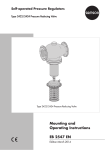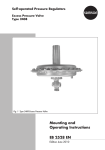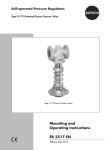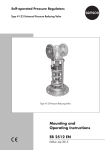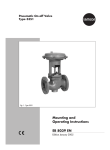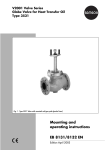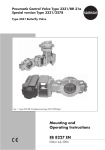Download Mounting and Operating Instructions EB 3009 EN
Transcript
Self-operated Pressure Regulators Check Valve Type 42-10 RS (Backflow Prevention) Type 42-10 RS Check Valve Mounting and Operating Instructions EB 3009 EN Edition January 2013 Contents Contents 1 Design and principle of operation . . . . . . . . . . . . . . . . . . 4 2 Installation . . . . . . . . . . . . . . . . . . . . . . . . . . . . . 5 2.1 2.2 2.3 Mounting position . . . . . . . . . . . . . . . . . . . . . . . . . . . . . . 5 Strainer . . . . . . . . . . . . . . . . . . . . . . . . . . . . . . . . . . . 5 Additional installation instructions . . . . . . . . . . . . . . . . . . . . . . 5 3 Operation. . . . . . . . . . . . . . . . . . . . . . . . . . . . . . 6 3.1 3.2 3.3 4 Start-up . . . . . . . . . . . . . . . . . . . . . . . . . . . . . . . . . . . 6 Set point adjustment . . . . . . . . . . . . . . . . . . . . . . . . . . . . . 6 Decommissioning . . . . . . . . . . . . . . . . . . . . . . . . . . . . . . 6 Maintenance . . . . . . . . . . . . . . . . . . . . . . . . . . . . 6 4.1 4.1.1 Replacing the diaphragm . . . . . . . . . . . . . . . . . . . . . . . . . . 6 Testing (in the workshop). . . . . . . . . . . . . . . . . . . . . . . . . . . 7 5 Description of the nameplates . . . . . . . . . . . . . . . . . . . . 9 6 Dimensions and weights . . . . . . . . . . . . . . . . . . . . . . 10 6.1 Technical data . . . . . . . . . . . . . . . . . . . . . . . . . . . . . . . 12 7 Customer service. . . . . . . . . . . . . . . . . . . . . . . . . . 13 2 EB 3009 EN Safety instructions General safety instructions 4 The regulators must be mounted, started up, and serviced by fully trained and qualified personnel only, observing the accepted industry codes and practices. Make sure employees or third persons are not exposed to any danger. All safety instructions and warnings in these instructions, particularly those concerning installation, start-up, and maintenance, must be observed. 4 The regulator complies with the requirements of the European Pressure Equip- ment Directive 97/23/EC. The Declaration of Conformity issued for devices bearing the CE marking includes information on the applied conformity assessment procedure and is available on request. 4 To ensure appropriate use, only use the regulator in applications where the op- erating pressure and temperatures do not exceed the operating values specified in the order. 4 Note that the manufacturer does not assume any responsibility for damage caused by external forces or any other external influences. 4 Any hazards which could be caused in the regulator by the process medium or 4 operating pressure are to be prevented by means of appropriate measures. Proper shipping and appropriate storage are assumed. Note The non-electric actuators and valve versions do not have their own potential ignition source according to the ignition risk assessment stipulated in EN 13463-1: 2009, section 5.2, even in the rare incident of an operating fault. Therefore, they do not fall within the scope of Directive 94/9/EC. For connection to the equipotential bonding system, observe the requirements specified in EN 60079-14: 2009 (VDE 0165 Part 1), section 6.3. EB 3009 EN 3 Design and principle of operation 1 Design and operation principle of The regulator controls the differential pressure to the set point adjusted and prevents backflow from directly connected systems. Observe the pressure and temperature limits on the nameplate. The regulator is open, provided the upstream pressure is at least 0.2 bar greater than the downstream pressure. It closes automatically when the downstream pressure rises to or above the value of the upstream pressure. The regulator basically consists of the valve (1) with seat and plug as well as the opening actuator (10) with two diaphragms (11). The medium flows through the valve in the direction indicated by the arrow. The position of the valve plug (3) determines the differential pressure across the free area between the plug (3) and the seat (2). At a differential pressure of 0.2 bar, the valve begins to open and at 0.35 bar the valve is fully open. At this point, the upstream pressure p1 (compressed air or nitrogen network pressure) must be greater than the downstream pressure p2. The valve closes automatically when the downstream pressure rises to or above the value of the upstream pressure. The standard plug is soft-seated to ensure tight shut-off and to prevent backflow from the plant into the compressed air or nitrogen network. The mounted control lines (14) transmit the high (+) pressure and low (–) pressure to the actuator. The actuator with two diaphragms (11) provides increased functional safety. The operat- 4 EB 3009 EN ing diaphragm for high pressure (11.1) is connected to the valve inlet pressure, whereas the operating diaphragm for low pressure (11.2) is connected to the valve outlet pressure. There is a hole with a mechanical diaphragm rupture indication (12) in the intermediate ring located between the two diaphragms. The pressure of response of the diaphragm rupture indication is approximately 1.5 bar. If the diaphragm ruptures, the pressure between the diaphragms will increase and cause the pin of the diaphragm rupture indication to move outward until the red marking appears to indicate the diaphragm rupture. The undamaged operating diaphragm will then take over the function of the damaged operating diaphragm. A pressure switch (15) can be optionally attached to the actuator to trigger an alarm. Installation 2 Installation NOTICE Protect the regulator against frost if it is used to control freezing media. In cases where the regulator is installed in rooms not free of frost, it must be removed from the pipeline when the plant is shut down. Choose the place of installation that allows you to freely access the regulator after the entire plant has been completed. NOTICE The valve must be installed free of stress. If necessary, support the pipe near the connecting flanges. However, do not attach the supports directly at the valve or actuator. Flush the pipeline thoroughly before installation. To prevent any sealing parts, weld spatter or other foreign matter carried along by the process medium from impairing the proper functioning of the valve, in particular, tight shut-off, install a strainer (e.g. SAMSON Type 2 NI) upstream of the regulator. 2.1 2.2 Make sure that the medium flow corresponds with the direction indicated by the arrow on the strainer body. Install the strainer with the filter element vertically suspended. Ensure that ample space is available to remove the filter. 2.3 Install the regulator in a horizontal pipeline as illustrated in Fig. 1 with the actuator suspended downwards. Make sure the direction of flow corresponds with the arrow on the valve body. 1 p1 2 3 + + Additional installation instructions We recommend the installation of hand-operated shut-off valves both upstream of the strainer and downstream of the regulator. This allows the plant to be shut down for cleaning and maintenance routines or when it is not operated for extended periods. Install pressure gauges upstream and downstream of the valve to monitor the pressures prevailing in the plant. Mounting position 4 Strainer 3 _ _ 4 p2 1 2 3 4 Strainer Type 42-10 RS Pressure gauge Shut-off valve p1 Upstream pressure p2 Downstream pressure Fig. 1 · Typical installation EB 3009 EN 5 Operation/Maintenance 3 Operation 3.1 Start-up First start up the regulator after mounting all the components. Make sure the control lines are correctly connected. Open all the valves on the consumer side. Then open the shut-off valves slowly. Raise the plant pressure in steps of 5 bar. Wait several seconds after each rise in pressure before continuing. NOTICE When pressure-testing the pipelines with the regulator installed, make sure the test pressure does not exceed 1.5 times the nominal pressure. The maximum permissible pressure in actuator must not be exceeded. The lowest pressure always applies. 3.2 Set point adjustment The regulator is delivered with the differential pressure set point fixed at 0.2 bar. 3.3 Decommissioning Close the shut-off valves starting with flow pipe (high-pressure line) in any order. The regulator is maintenance-free, but is subject to wear and tear, especially at the seat, plug and two diaphragms. Depending on the application conditions that prevail, the regulator must be inspected at appropriately scheduled intervals to prevent any problems before they occur. Detailed test instructions (1700-0336) are available on request. Refer to Table 1 on page 8 for troubleshooting. Contact SAMSON if any problems cannot be remedied. Proceed as described in section 4.1 when the diaphragm rupture indicator is triggered or when one of the diaphragms is defective. NOTICE Prior to carrying out any work on the regulator, depressurize and drain the corresponding section of the plant. Depending on the application, first allow the relevant section of the plant to cool down or warm up to reach ambient temperatures. As valves are not free of cavities, there might still be residual medium in the valve. 4.1 Replacing the diaphragm Note We recommend replacing both diaphragms when the diaphragm rupture indicator is triggered or when one of the diaphragms is defective. 4 6 Maintenance EB 3009 EN Maintenance The valve does not need to be removed from the pipeline to replace the diaphragms. After shutting off and draining the corresponding section of the plant, unscrew the control lines (14). To separate the actuator from the valve body (1), undo the coupling nut (5) and remove the diaphragm actuator (10). How to proceed NOTICE Remove the actuator housing (10) together with the intermediate ring (10.1). The installed set point springs (13) and force limiter springs (13.1) are still compressed. Unscrew first the short housing screws (16.1) and then the long screws (16.2) in an even manner. 1. Unthread screws (16.1) and lift the top part off the actuator housing. 2. Unthread screws (16.2) and remove the intermediate ring (10.1) together with the two diaphragms (11.1/11.2), while pulling the diaphragm stem (7) off the bottom diaphragm housing. 3. Disassemble the double diaphragm (11) with the diaphragm plates enough to be able to replace the two diaphragms (11.1/11.2). To do so, unthread top diaphragm plate nut (17), while holding the bottom diaphragm stem or opposite nut stationary with a suitable tool. 4. Lift off the top diaphragm plate and diaphragm (11.1) together with the bottom diaphragm plate. Pull out the spacer bushing (18). 5. Unthread nut (17.1), while holding the stem stationary with a suitable tool. Replace bottom diaphragm (11.2). Proceed in reverse order to reassemble. Observe the tightening torques specified in Fig. 4! Proceed as described in section 3.1 for start up. 4.1.1 Testing (in the workshop) Detailed test instructions (1700-0336) are available on request. Perform leakage and function tests after replacing the diaphragms. To proceed, install the valve with actuator and control lines into a suitable setup that allows the test pressure to be applied. Note Flow of direction: Arrow on body A Þ B a. Internal leakage test (shut-off between seat and plug) · Apply compressed air at 0.1 bar to port A (flow side) Open port B (return flow side) DN 15 to 25 Test pressure Leakage, max. l/h 32 to 50 65 to 100 125/ 150 p = 0.1 bar 30 60 100 200 b. External leakage test Apply compressed air at 10 bar to port A (flow side). Tightly seal port B (return flow side) · The valve body should show no signs of leakage. EB 3009 EN 7 Maintenance c. Function test Port A (flow side) · Apply a test pressure of p = 0.3 bar Þ The plug should open. d. Backflow prevention function test DN Test pressure 15 to 25 32 to 50 65 to 100 125/ 150 p = 0.1 bar ® Bubble-tight p = 10 bar ® Bubble-tight Port A is open · Apply compressed air at 0.1 bar to port B (return flow side). Slowly increase the pressure to 10 bar. Check for leakage at the seat. Table 1 · Troubleshooting Problem Possible cause Solution Valve does not fully open · Differential pressure rises above the adjusted set point Insufficient pressure can be tapped on high-pressure side, connected to the actuator Clean control line and screw fitting. Two diaphragms defective (see diaphragm rupture indicator) Replace diaphragm (see section 4.1). Seat and plug worn due to deposits or foreign matter Replace damaged parts or contact SAMSON. Strainer blocked up Clean strainer filter. Valve sized too small Recalculate KVS coefficient and contact SAMSON. Seat and plug damaged, meaning a tight shut-off is no longer possible Remove valve from pipeline and clean parts. Contact SAMSON if still defective. Valve sized too big Recalculate KVS coefficient and contact SAMSON. Control line on low pressure side blocked Clean control line and screw joint. Jerky control performance Increased friction, e.g. due to foreign matter lodged between seat and plug Remove valve from pipeline and clean parts. Control loop hunting Valve sized too big Recalculate KVS coefficient and contact SAMSON. Valve does not close · Differential pressure drops below the adjusted set point 8 EB 3009 EN Description of the nameplates 5 Description of the nameplates Both the valve and actuator have a nameplate. Valve nameplates DIN version 1 Valve type 2 3 Model number with index Configuration ID (Var.-ID) 4 Order number or date KVS coefficient 5 8 9 Nominal size Nominal pressure 10 Perm. differential pressure 11 12 Perm. temperature Body material ANSI version 5 Nominal size 8 Perm. differential pressure 9 Perm. temperature (°F) 10 Body material 11 CV (KVS x 1.17) 12 ANSI Class (pressure rating) Actuator nameplate 6 2 SAMSON Pmax bar 1 3 Var.-ID psi DN bar 9 psi No size cm² 5 sq.in 2002 1 2 3 4 5 6 EPDM Made in Germany 7 4 10 0062 7 9 10 Effective area (DIN/ANSI) Type Configuration ID (Var.-ID) ID number Year of production with CE marking Max. perm. pressure pmax (DIN/ANSI) Nominal size of associated valve (DIN/ANSI) Set point range (DIN/ANSI) Diaphragm material Fig. 2 · Nameplates EB 3009 EN 9 Dimensions and weights 6 Dimensions and weights Type 42-10 RS Dimensions in mm and weights in kg Nominal size DN 15 20 25 32 40 50 65 80 100 125 150 Length L 130 150 160 180 200 230 290 310 350 400 480 355 460 590 120 145 175 – – – Height H1 Height H2 225 Other materials Forged steel 55 53 Height H Fig. 3 · Dimensions and weights 10 EB 3009 EN – 72 70 – 550 Actuator Weight in kg 300 92 100 98 600 27 28 37 38 – 800 Ø D = 285 mm · A = 320 cm² 26 – 830 1000 Ø D = 390 mm · A = 640 cm² 41 62 68 77 110 165 Dimensions and weights Sectional diagram 1 2 3 1 2 3 4 5 6 7 10 10.1 11 11.1 11.2 12 13 13.1 14 15 16 16.1 16.2 17 17.1 18 Valve body Seat Plug Plug stem Threaded connection for actuator Actuator stem 14 Diaphragm stem Actuator housing Intermediate ring 18 Two diaphragms Operating diaphragm 11.1 for high pressure Operating diaphragm for low pressure 16 Diaphragm rupture indication 11 10.1 Set point spring(s) Force limiting springs Control line 8 x 1 mm 11.2 Pressure switch (option) Housing screws (two screws opposite each 17.1 other – DN 15 to DN 25 only –) (20Nm) Top housing screws Bottom housing screws Diaphragm plate nut (external) Diaphragm plate nut (inside) Spacer bushing 4 5 14 6 13.1 17 16.1 (25Nm) 12 16.2 (25Nm) 10 13 7 15 Fig. 4 · Sectional diagram EB 3009 EN 11 6.1 Technical data Type 2421 RS Valve Nominal size DN KVS coefficient 15 20 25 32 40 50 65 80 100 125 150 4 6.3 8 16 20 32 50 80 125 190 280 Nominal pressure PN 25 or 40 Max. perm. continuous operating pressure 25 bar Max. perm. pressure on one side 45 bar Leakage class acc. to IEC 60534-4 Leakage rate VI Max. perm. temperature 150 °C Type 2420 RS Actuator Diaphragm area of actuator 320 cm² 640 cm² Differential pressure set point, fixed Max. permissible temperature 0.2 bar Air and gases up to 80 °C Terms for valve sizing according to IEC 60534: FL = 0.95; xT = 0.75 12 EB 3009 EN Customer service 7 Customer service Should any malfunctions or any defect occur, SAMSON's After-Sales Service is prepared to help you on site. You can also send the defective regulator directly to your local SAMSON representative for repair. Addresses of SAMSON subsidiaries, agencies and service centers are listed in the product catalogs and in the Internet at www.samson.de. To allow SAMSON to find the fault and to have an idea of the installation situation, specify the following details (refer to the nameplate): 4 Type, nominal size and set point range of the regulator 4 Order number 4 Model number of valve and actuator 4 Inlet pressure and outlet pressure 4 Process medium and its temperature 4 Min. and max. flow rate 4 Min. and max. medium temperature 4 Sketch of the installation with exact position of regulator and all additional installed components (shut-off valves, pressure gauges, etc.). EB 3009 EN 13 14 EB 3009 EN EB 3009 EN 15 EB 3009 EN S/Z 2013-02 SAMSON AG · MESS- UND REGELTECHNIK Weismüllerstraße 3 · 60314 Frankfurt am Main · Germany Phone: +49 69 4009-0 · Fax: +49 69 4009-1507 Internet: http://www.samson.de Conversion from chromate coating to iridescent passivation Conversion from chromate coating to iridescent passivation We at SAMSON are converting the surface treatment of passivated steel parts in our production. As a result, you may receive a device assembled from parts that have been subjected to different surface treatment methods. This means that the surfaces of some parts show different reflections. Parts can have an iridescent yellow or silver color. This has no effect on corrosion protection. For further information, go to u www.samson.de/chrome-en.html



















